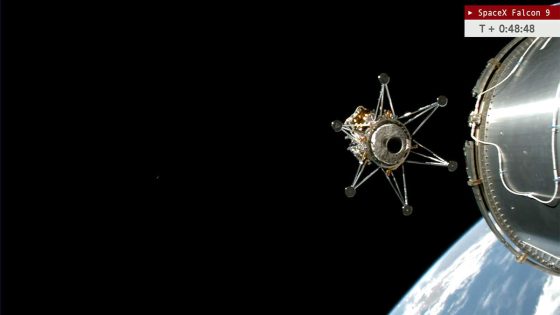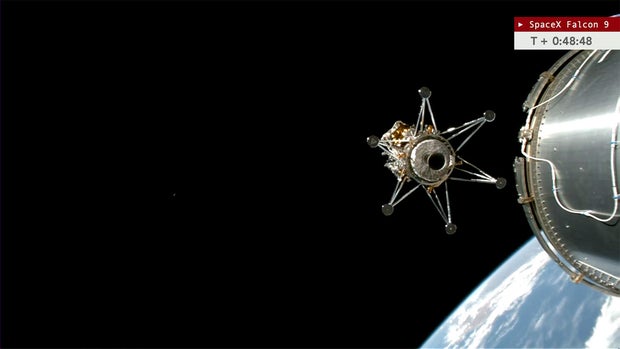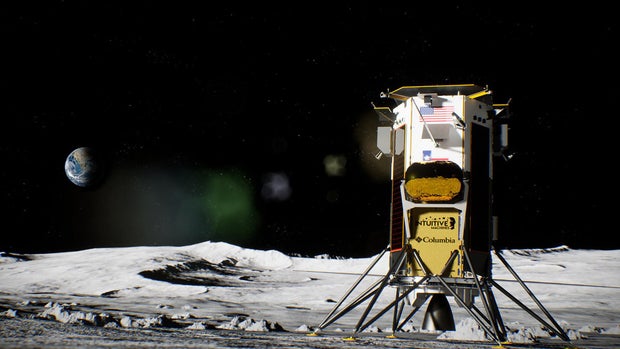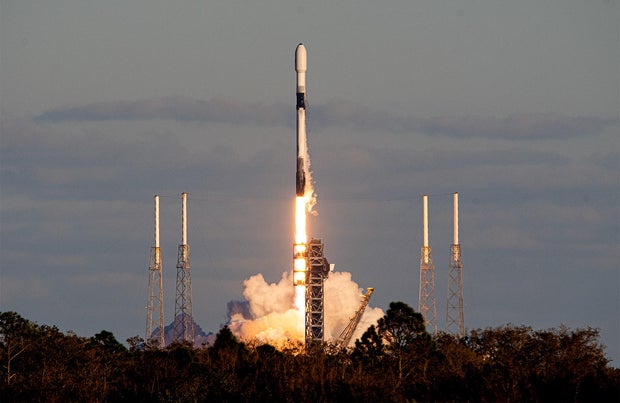Lighting up the deep overnight sky, a Falcon 9 rocket thundered away from Florida early Thursday, boosting a commercially built robotic lander on a flight to the moon. If successful, it will become the first American spacecraft to reach the lunar surface in more than 50 years.
It was SpaceX’s second flight in less than eight hours, following launch of six U.S. Space Force missile detection and tracking satellites earlier in the day, and the third launch to orbit worldwide counting a Russian space station cargo ship that took off from Kazakhstan.
SpaceX
Launch of another Falcon 9 carrying a batch of 22 Starlinks, this one at Vandenberg Space Force Base in California, was called off without explanation.
But the Florida moonshot brought a busy day in space to a spectacular conclusion with a picture-perfect liftoff at 1:05 a.m. EST Thursday, five weeks after another commercial lander built by Pittsburg-based Astrobotic suffered a mission-ending malfunction.
Thursday’s launching went off without a hitch, and Intuitive Machines’ Odysseus lander was released to fly on its own 48 minutes after liftoff. If all goes well, the spacecraft will brake into orbit around the moon and descend to the surface next Thursday, touching down about 186 miles from the moon’s south pole.
Partially funded by NASA, the flight is a trail blazer of sorts for the agency’s Artemis program, which plans to send astronauts to the moon’s south polar region in the next few years. NASA instruments aboard Odysseus will study the lunar environment and test needed technologies for downstream missions.
To reach its landing site, Odysseus will rely on a high-power 3D-printed main engine burning liquid oxygen and methane propellants, a first for a deep space mission. Problems loading the lander with properly chilled methane forced SpaceX to order a 24-hour launch delay, but there were no known issues Thursday.
Odysseus carries six NASA instruments and another six commercial payloads, including sculptures, proof-of-concept cloud storage technology, insulation blankets provided by Columbia Sportswear and a student-built camera package that will drop to the surface ahead of the lander to photograph its final descent.
Among the NASA experiments is an instrument to study the charged particle environment at the moon’s surface, another that will test navigation technologies and downward-facing stereo cameras designed to photograph how the lander’s engine exhaust disrupts the soil at the landing site.
Intuitive Machines
Also on board: an innovative sensor that will use radio waves to accurately determine how much cryogenic propellant is left in a tank in the weightless environment of space, technology expected to prove useful for future moon missions and other deep space voyages.
Odysseus and its experiments are expected to operate for about a week on the moon’s surface before the sun sets at the landing site, cutting off solar power. The spacecraft is not designed to survive the extreme low temperatures of the two-week lunar night.
Only the United States, Russia, China, India and Japan have successfully put landers on the surface of the moon, and Japan’s membership in that exclusive club comes with an asterisk: its “SLIM” lander tipped over on touchdown Jan. 19 and failed to achieve all of the mission’s objectives.
Three privately funded moon landers were launched between 2019 and this past January, one from an Israeli non-profit, one from a Japanese company and Astrobotic’s ill-fated Peregrine. All three failed.
Peregrine and Odysseus were both funded in part by NASA’s Commercial Lunar Payload Services program, or CLPS (pronounced CLIPS), designed to encourage private industry to develop transportation capabilities that NASA can then use to transport payloads to the moon.
The agency’s goal is to help kickstart development of new technologies and to collect data that will be needed by Artemis astronauts planning to land near the moon’s south pole later this decade.
The agency spent about $108 million for its part in the Peregrine mission and another $129 million for the Odysseus instruments and transportation to the moon.
Intuitive Machines
“These aren’t NASA missions, they’re commercial missions,” said Susan Lederer, CLPS project scientist at the Johnson Space Center. “These commercial companies will be bringing our instruments along for the ride, enabling our investigations by providing power, data and (communications) to us.
“With the commercial industry comes a competitive environment, which means that our investment up front ultimately gets far more for far less. So instead of one mission in a decade, it allows for more like 10 commercial missions to the moon in a decade.”
The Intuitive Machines launch capped a busy day for SpaceX.
At 5:30 p.m., a Falcon 9 rocket blasted off from pad 40 at the Cape Canaveral Space Force Station carrying four Space Development Agency missile tracking satellites and two hypersonic threat detection satellites for the Missile Defense Agency.
William Harwood/CBS News
The two MDA satellites are designed to continuously track ultra-high-speed missiles or other threats, handing off to other satellites or ground systems for targeting. They will work in the same orbit as the SDA tracking satellites to help planners assess how threats can be managed at multiple levels.
The four SDA tracking satellites were the final members of a 27-satellite constellation fielded by the SDA in “tranche 0” of its “proliferated warfighter space architecture.” Additional satellites will be launched in the next few years to populate additional tranches, or constellations of increasingly capable spacecraft.
The $4.5 billion U.S. Space Force program aims to deploy hundreds of small laser-linked tracking and data relay satellites distributed in multiple constellations and orbital planes to provide global coverage that is less vulnerable to attack.
With the Space Force flight safely on its way, SpaceX engineers on the West Coast attempted to launch 22 Starlink internet satellites from Vandenberg Space Force Base northwest of Los Angeles. But SpaceX called off that flight at the end of its launch window.
On the other side of the planet at the Baikonur Cosmodrome in Kazakhstan, Russian engineers launched the Progress MS-26/67P cargo ship at 10:25 p.m. EST, kicking off a two-day flight to the International Space Station.
The Progress is loaded with 5,500 pounds of cargo, including 3,258 pounds of dry goos, 1,279 pounds of space station propellant and 926 pounds of water. Docking at the station’s Zvezda module is expected at 1:26 a.m. EST Saturday.
Source Agencies






